Development of Sustainable Partnership Organizational Mechanism (POM): Case of Local Action Groups (LAG)
Abstract
1. Introduction
2. Materials and Methods
2.1. Organizational Mechanism
2.2. POM Sustainability Discourse
2.3. Methods of the Research
2.4. Methodology for Typological Modelling of Partnership Organizational Mechanisms
2.5. Outline of Long-Term Observation
2.6. Multimethod-Based Design
3. Results
3.1. Unbalanced Models of POM
3.2. Balanced Models of POM Leading to Grater Sustainability
4. Discussion and Conclusions
Author Contributions
Funding
Institutional Review Board Statement
Informed Consent Statement
Data Availability Statement
Conflicts of Interest
References
- Mathis, K.A.; Bronstein, J.L. Our Current Understanding of Commensalism. Annu. Rev. Ecol. Evol. Syst. 2020, 51, 167–189. [Google Scholar] [CrossRef]
- Roostaie, S.; Nawari, N.; Kibert, C. Integrated sustainability and resilience assessment framework: From theory to practice. J. Clean. Prod. 2019, 232, 1158–1166. [Google Scholar] [CrossRef]
- Linnenluecke, M.K. Resilience in business and management research: A review of influential publications and a research agenda. Int. J. Manag. Rev. 2015, 19, 4–30. [Google Scholar] [CrossRef]
- Lew, A.A.; Ng, P.T.; Ni, C.-C.; Wu, T.-C. Community sustainability and resilience: Similarities, differences and indicators. Tour. Geogr. 2015, 18, 18–27. [Google Scholar] [CrossRef]
- Xu, L.; Marinova, D.; Guo, X. Resilience thinking: A renewed system approach for sustainability science. Sustain. Sci. 2015, 10, 123–138. [Google Scholar] [CrossRef]
- Vaitkevicius, S.; Papsiene, P.; Vaitkevicius, J.V. Rethinking a timely response of human resources to global signals: A case of organizational reflexes. Eng. Econ. 2021, 32, 48–59. [Google Scholar] [CrossRef]
- Linnenluecke, M.K.; McKnight, B. Community resilience to natural disasters: The role of disaster entrepreneurship. J. Enterprising Communities People Places Glob. Econ. 2017, 11, 166–185. [Google Scholar] [CrossRef]
- Kanie, N.; Biermann, F. Governing through Goals: Sustainable Development Goals as Governance Innovation; Mit Press: Cambridge, MA, USA, 2017. [Google Scholar]
- Xu, L.; Marinova, D.; Xin, P.; Guo, X. Resilience-Based sustainability indicators for freshwater lakes with application for Dongting Lake, China. Environ. Nat. Resour. Res. 2015, 5, 165. [Google Scholar] [CrossRef][Green Version]
- George, R.A.; Siti-Nabiha, A.; Jalaludin, D. Sustainability institutionalisation: A mechanistic approach to control change. J. Clean. Prod. 2018, 205, 36–48. [Google Scholar] [CrossRef]
- Arenas, A.; Díaz-Guilera, A.; Kurths, J.; Moreno, Y.; Zhou, C. Synchronization in complex networks. Phys. Rep. 2008, 469, 93–153. [Google Scholar] [CrossRef]
- Stareike, E. Partnerystes Organizacinio Mechanizmo Fenomenas Vietos Veiklos Grupeje (The Phenomenon of the Partnership Organisational Mechansm in Local Action Group). Ph.D. Dissertation, Aleksandras Stulginskis University, Akademija, Lithuania, 2017. [Google Scholar]
- Jackson, M.O. Mechanism Theory; EOLSS: Oxford, UK, 2003. [Google Scholar]
- Hurwicz, L. The design of mechanisms for resource allocation. Am. Econ. Rev. 1973, 63, 1–30. [Google Scholar]
- Maskin, E.; Sjostrom, T. Implementation theory. In Handbook of Social Choice Theory; Arrow., K., Sen., A., Suzumura, K., Eds.; North Holland: Amsterdam, The Netherlands, 2002; Volume I, pp. 237–288. Available online: https://scholar.harvard.edu/files/maskin/files/implementation_theory_published_version.pdf (accessed on 7 December 2020).
- Baliga, S.; Maskin, E. Mechanism Design for the Environment. In Handbook of Environmental Economics; Mäler, K.G., Vincent, J., Eds.; North-Holland: Amsterdam, The Netherlands, 2003; Volume 1. [Google Scholar]
- Maskin, E.S. Mechanism design: How to implement social goals. Am. Econ. Rev. 2008, 98, 567–576. [Google Scholar] [CrossRef]
- Lebel, L.; Anderies, J.; Campbell, B.; Folke, C.; Hatfield-Dodds, S.; Hughes, T.; Wilson, J. Governance and the capacity to manage resilience in regional social-ecological systems. Ecol. Soc. 2006, 11, 19. [Google Scholar] [CrossRef]
- Grandori, A.; Furnari, S. A chemistry of organization: Combinatory structural analysis and design. Organ. Stud. 2008, 29, 459–485. [Google Scholar] [CrossRef]
- Grandori, A. Democratic governance and the firm. Rev. Adm. 2017, 52, 353–356. [Google Scholar] [CrossRef]
- Anderson, P.J.J.; Blatt, R.; Christianso, M.K.; Grant, A.M.; Marquis, C.; Neuman, E.J.; Sonenshein, S.; Sutcliffe, K.M. Understanding mechanisms in organizational research: Reflections from a collective journey. J. Manag. Inq. 2006, 15, 102–113. [Google Scholar] [CrossRef]
- Mechkour, S. Overview of Situation Theory and Its Application in Modelling Context; Seminar Paper; Department of Informatics, University of Fribourg: Fribourg, Switzerland, 2007. [Google Scholar]
- Hedstrom, P.; Swedberg, R. Social mechanisms. In An Analytical Approach to Social Theory; Cambridge University Press: Cambridge, UK, 1998. [Google Scholar]
- Stinchcombe, A.L. The conditions of fruitfulness of theorizing about mechanisms in social science. Philos. Soc. Sci. 1991, 21, 367–388. [Google Scholar] [CrossRef]
- Weber, M. Bureaucracy. In Working in America; Routledge: London, UK, 2015; pp. 29–34. [Google Scholar]
- King, D.C.; Bennis, W.G.; Schein, E.H.; Berlew, D.E.; Steele, F.I. Interpersonal dynamics: Essays and readings on human interaction. ILR Rev. 1965, 19, 143. [Google Scholar] [CrossRef]
- McNally, J. The Functions of the Executive, by Chester Barnard; Harvard University Press: Cambridge, MA, USA, 1938. [Google Scholar]
- Simon, H.A. Administrative Behavior; Simon and Schuster: New York, NY, USA, 2013. [Google Scholar]
- Leach, W.D.; Pelkey, N.W.; Sabatier, P.A. Stakeholder partnerships as collaborative policymaking: Evaluation criteria applied to watershed management in California and Washington. J. Policy Anal. Manag. 2002, 21, 645–670. [Google Scholar] [CrossRef]
- Glasbergen, P.; Biermann, F.A.; Mol, P.J. Partnerships, Governanceand Sustainable Development: Reflections on Theory; Edward Elgar Publishing: Cheltenham, UK, 2007. [Google Scholar]
- Van Huijstee, M.M.; Francken, M.; Leroy, P. Partnerships for sustainable development: A review of current literature. Environ. Sci. 2007, 4, 75–89. [Google Scholar] [CrossRef]
- Greve, C.; Hodge, G. Public-private partnerships and public governance challenges. In The New Public Governance: Emerging Perspectives on the Theory and Practice of Public Governance; Routledge: London, UK, 2010; pp. 149–162. [Google Scholar] [CrossRef]
- McQuaid, R. Theory of Organizational Partnerships: Partnership advantages, disadvantages and success factors. In The New Public Governance? Emerging Perspectives on the Theory and Practice of Public Governance; Osborn, S.P., Ed.; Routledge: London, UK, 2010; pp. 127–148. [Google Scholar]
- Benington, J.; Geddes, M. Local Partnership and Social Exclusion in the European Union: New Forms of Local Social Governance? Routledge: London, UK, 2013. [Google Scholar]
- Mohr, J.; Spekman, R. Characteristics of partnership success: Partnership attributes, communication behavior, and conflict resolution techniques. Strat. Manag. J. 1994, 15, 135–152. [Google Scholar] [CrossRef]
- Macken-Walsh, Á.; Curtin, C. Governance and rural development: The case of the rural partnership programme (rpp) in post-socialist lithuania. Sociol. Rural. 2013, 53, 246–264. [Google Scholar] [CrossRef]
- Fernandez-Gimenez, M.; Augustine, D.J.; Porensky, L.M.; Wilmer, H.; Derner, J.; Briske, D.D.; Stewart, M.O. Complexity fosters learning in collaborative adaptive management. Ecol. Soc. 2019, 24, 21. [Google Scholar] [CrossRef]
- Sisto, R.; Lopolito, A.; van Vliet, M. Stakeholder participation in planning rural development strategies: Using backcasting to support Local Action Groups in complying with CLLD requirements. Land Use Policy 2018, 70, 442–450. [Google Scholar] [CrossRef]
- Cronwall, A. Making Spaces, Changing Places: Situating Participation in Development. 2002. Available online: https://opendocs.ids.ac.uk/opendocs/bitstream/handle/123456789/3932/Wp170.pdf (accessed on 3 May 2021).
- Bueret, J.E. Biodiversity and stakeholders: Concertation itineraries. In Dialogue and Concertation in Biosfere Reserves: Issues and Challenges; Technical Notes: London, UK, 2006. [Google Scholar]
- Gone, J.P. Research reservations: Response and responsibility in an american indian community. Am. J. Community Psychol. 2006, 37, 183–189. [Google Scholar] [CrossRef]
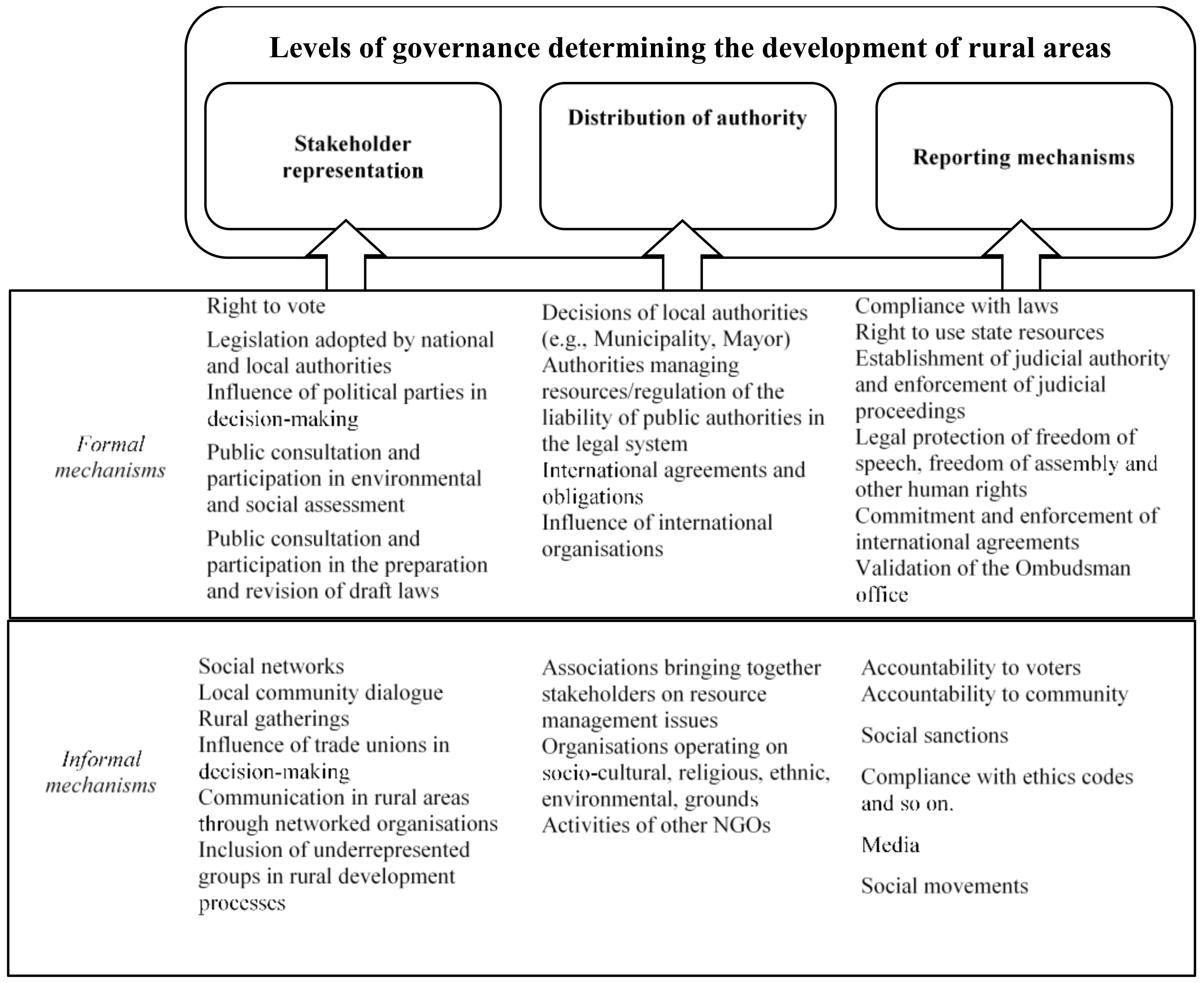

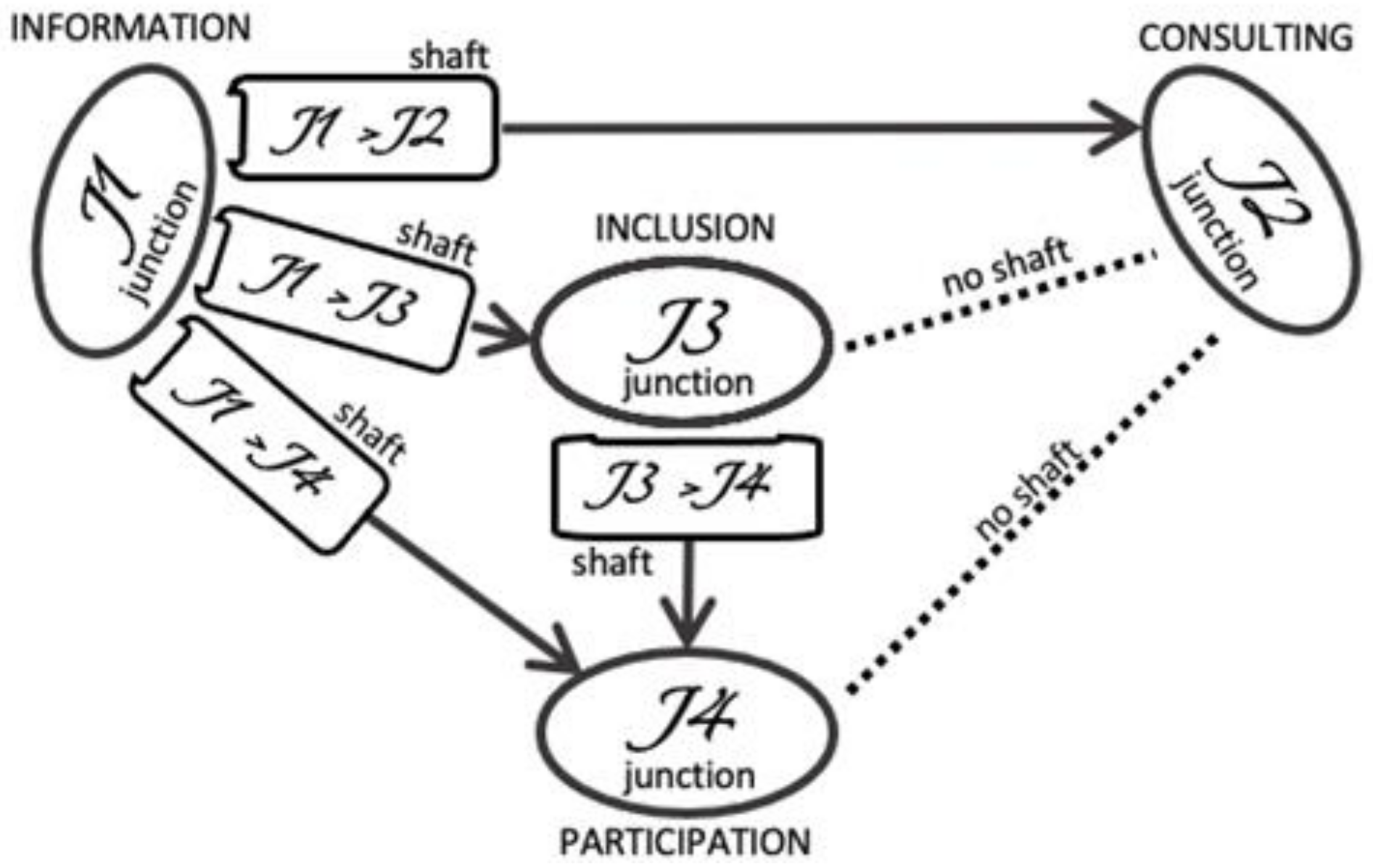




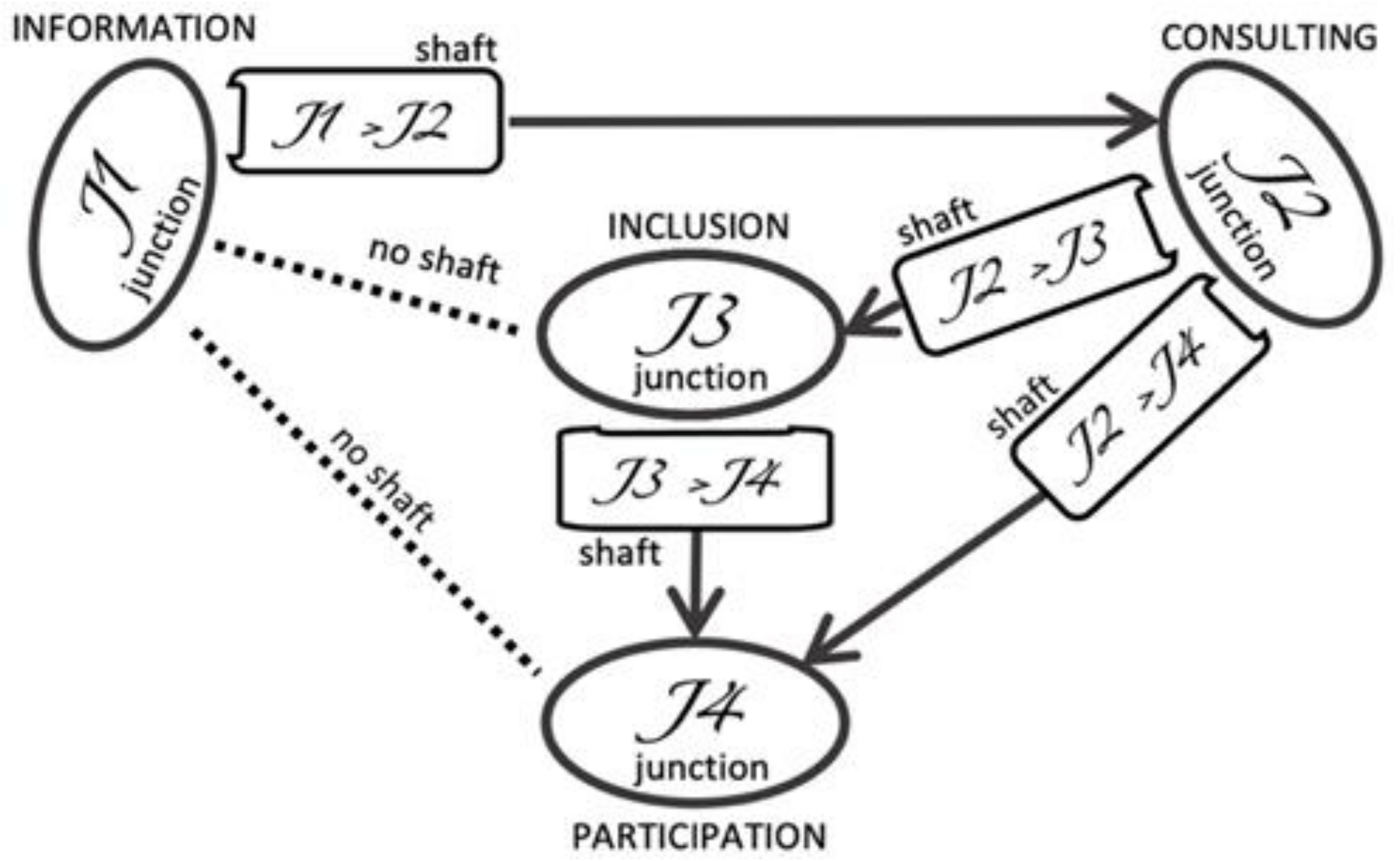
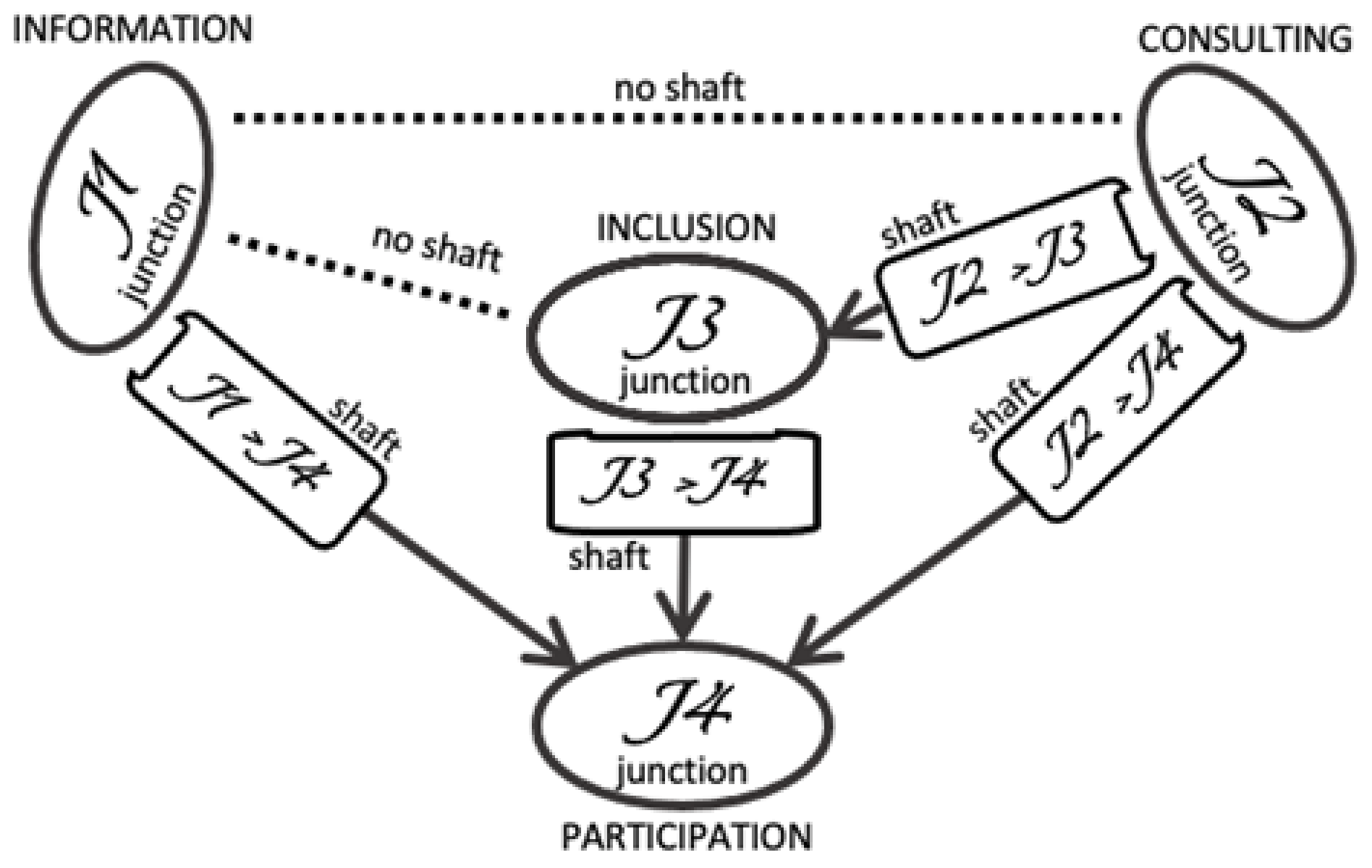

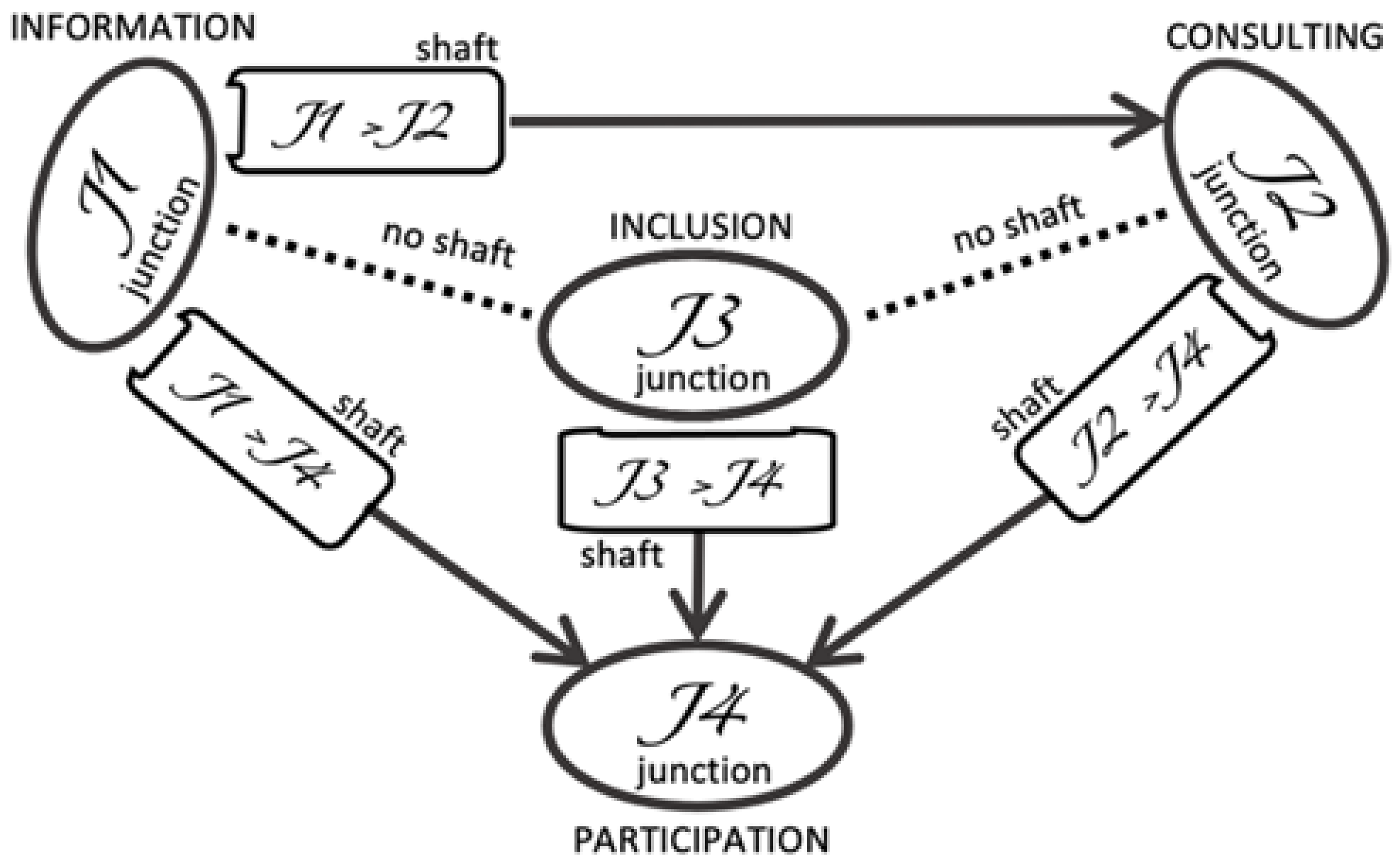
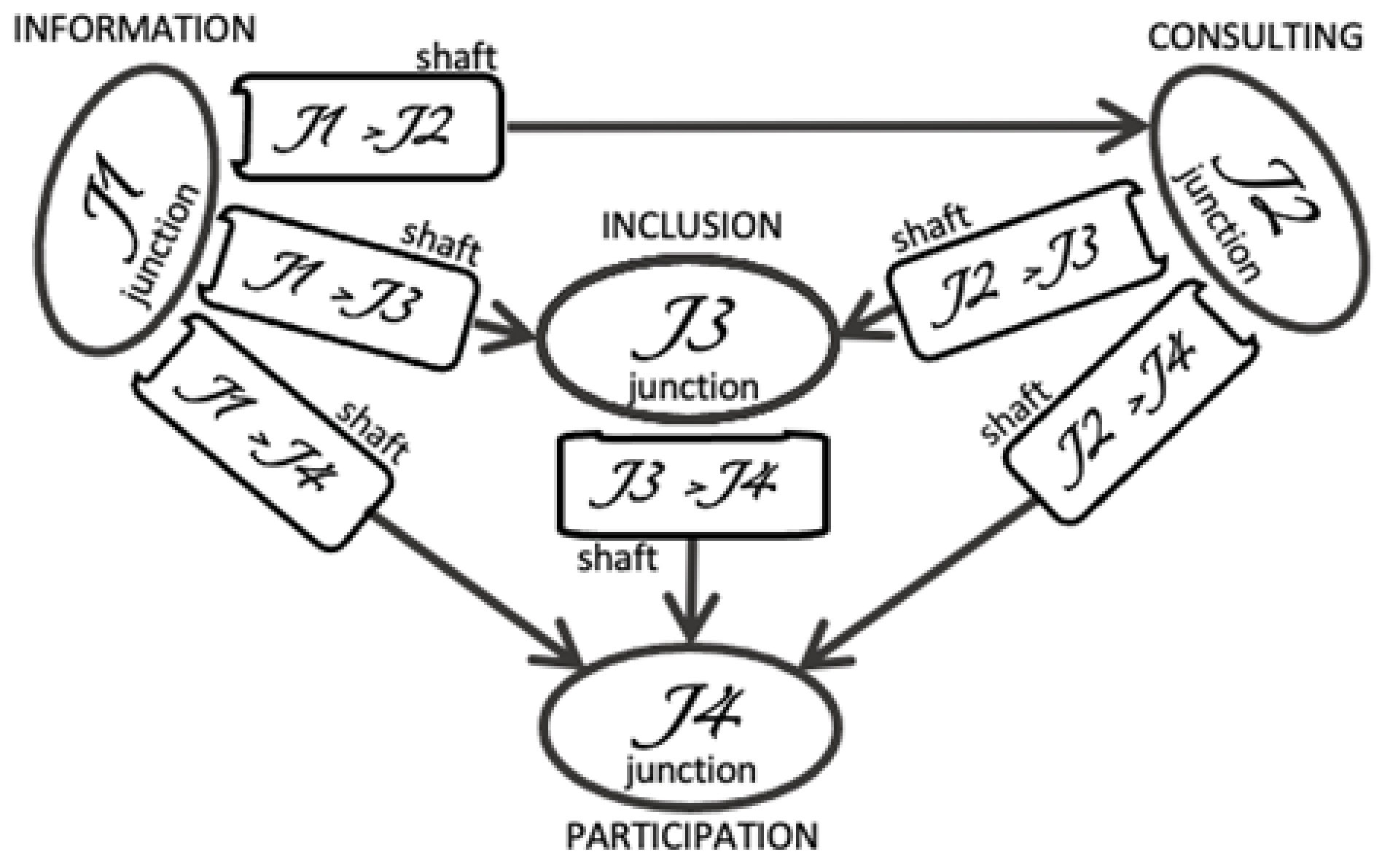
| The Role of Junction * | |||
|---|---|---|---|
| Information | Consulting | Inclusion | Participation |
| I1—Communication I2—Direction I3—Initiation I4—Introduction | C1—Expression of opinion C2—Knowledge transfer C3—Recommendation C4—Advice on how to proceed C5—Presentation of an expert or specialist opinion | Ic1—Bringing together Ic2—Cooperation Ic3—Empowerment Ic4—Motivation Ic5—Pooling of resources | P1—Information exchange P2—Development of dialogue P3—Representation P4—Discussion P5—Conciliation P6—Negotiation |
| Information |  I1—Communication | Consulting |  C1—Expression of opinion |
 I2—Direction |  C2—Knowledge transfer | ||
 I3—Initiation |  C3—Recommendation | ||
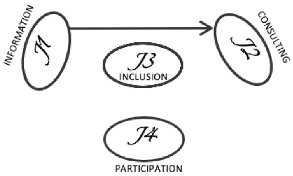 I4—Introduction |  C4—Advice on how to proceed | ||
| Participation |  P1—Information exchange |  C5—Presentation of an expert or specialist opinion | |
 P2—Development of dialogue | Inclusion |  Ic1—Bringing together | |
 P3—Representation |  Ic2—Cooperation | ||
 P4—Discussion |  Ic3—Empowerment | ||
 P5—Conciliation |  Ic4—Motivation | ||
 P6—Negotiation |  Ic5—Pooling of resources |
| J1 Information | |||||||||
|---|---|---|---|---|---|---|---|---|---|
| Primary variables | That it would be possible: | Latent variables | Factor score | Corrected Item-Total Correlation | |||||
| To Consult (J1-1) | To Include (J1-2) | To Inspire to Participate (J1-3) | |||||||
| Factor score | Corrected Item-Total Correlation | Factor score | Corrected Item-Total Correlation | Factor score | Corrected Item-Total Correlation | ||||
| Direction | 0.831 | 0.648 | 0.901 | 0.816 | 0.901 | 0.814 | |||
| Knowledge transfer | 0.813 | 0.649 | 0.867 | 0.765 | 0.843 | 0.725 | To Consult (J1-1) | 0.686 | 0.464 |
| Introduction | 0.804 | 0.641 | 0.877 | 0.779 | 0.927 | 0.859 | To Include (J1-2) | 0.969 | 0.877 |
| Leading towards | 0.738 | 0.549 | 0.895 | 0.809 | 0.865 | 0.759 | To Inspire to Participate (J1-3) | 0.920 | 0.876 |
| KMO | Bartlett’s Test of Sphericity Sig. | Extraction Sums of Squared Loadings | Cronbach’s Alpha | Inter-Item Correlations | |||||
| Total | % of Variance | Mean | Minimum | Maximum | |||||
| J1-1 | 0.611 | 0.000 | 2.543 | 63.574 | 0.802 | 0.513 | 0.355 | 0.640 | |
| J1-2 | 0.844 | 0.000 | 3.135 | 78.372 | 0.907 | 0.711 | 0.656 | 0.742 | |
| J1-3 | 0.839 | 0.000 | 3.131 | 78.282 | 0.904 | 0.709 | 0.605 | 0.799 | |
| J1 Information | 0.506 | 0.000 | 2.256 | 75.211 | 0.826 | 0.612 | 0.378 | 0.926 | |
| J2 Consulting | ||||||||
|---|---|---|---|---|---|---|---|---|
| Primary variables | That it would be possible: | Latent variables | Factor score | Corrected Item-Total Correlation | ||||
| To Include (J2-1) | To Inspire to Participate (J2-2) | |||||||
| Factor score | Corrected Item-Total Correlation | Factor score | Corrected Item-Total Correlation | |||||
| Expressed opinion | 0.791 | 0.614 | 0.848 | 0.707 | ||||
| Provided specialist/expert opinion | 0.785 | 0.661 | 0.725 | 0.606 | ||||
| Recommended | 0.768 | 0.580 | 0.911 | 0.802 | ||||
| Advised | 0.748 | 0.598 | 0.804 | 0.687 | To Include (J2-1) | 0.969 | 0.876 | |
| Communicated | 0.724 | 0.607 | 0.860 | 0.593 | To Inspire to Participate (J2-2) | 0.969 | 0.876 | |
| KMO | Bartlett’s Test of Sphericity Sig. | Extraction Sums of Squared Loadings | Cronbach’s Alpha | Inter-Item Correlations | ||||
| Total | % Of Variance | Mean | Minimum | Maximum | ||||
| J2-1 | 0.695 | 0.000 | 2.916 | 58.329 | 0.808 | 0.478 | 0.310 | 0.742 |
| J2-2 | 0.782 | 0.000 | 3.460 | 69.192 | 0.859 | 0.611 | 0.463 | 0.859 |
| J2 Consulting | 0.500 | 0.000 | 1.876 | 93.819 | 0.934 | 0.876 | 0.876 | 0.876 |
| Partnership Organisation Mechanism (POM) | ||||||||
|---|---|---|---|---|---|---|---|---|
| J3 Primary variables | That it would be possible: | J4 Primary variables | By Participating (J4 Participation) | Latent variables | Factor score | Corrected Item-Total Correlation | ||
| To Inspire to Participate (J3 Inclusion) | ||||||||
| Factor score | Corrected Item-Total Correlation | Factor score | Corrected Item-Total Correlation | |||||
| Communicated | 0.783 | 0.627 | ||||||
| Bringing together | 0.894 | 0.799 | Developing dialogue | 0.770 | 0.586 | |||
| Cooperation | 0.587 | 0.456 | Represented | 0.590 | 0.443 | J1 Information | 0.866 | 0.757 |
| Enabling | 0.828 | 0.704 | Debated | 0.822 | 0.681 | J2 Consulting | 0.888 | 0.791 |
| Motivated | 0.890 | 0.788 | Reconciliation | 0.674 | 0.557 | J3 Inclusion | 0.885 | 0.788 |
| Pooling resources | 0.821 | 0.713 | Ongoing negotiations | 0.759 | 0.648 | J4 Participation | 0.850 | 0.735 |
| KMO | Bartlett’s Test of Sphericity Sig. | Extraction Sums of Squared Loadings | Cronbach’s Alpha | Inter-Item Correlations | ||||
| Total | % Of Variance | Mean | Minimum | Maximum | ||||
| J3 | 0.832 | 0.000 | 3.297 | 65.939 | 0.866 | 0.562 | 0.344 | 0.817 |
| J4 | 0.643 | 0.000 | 3.259 | 54.319 | 0.810 | 0.446 | 0.206 | 0.793 |
| OMP | 0.812 | 0.000 | 3.044 | 76.098 | 0.895 | 0.681 | 0.600 | 0.755 |
Publisher’s Note: MDPI stays neutral with regard to jurisdictional claims in published maps and institutional affiliations. |
© 2021 by the authors. Licensee MDPI, Basel, Switzerland. This article is an open access article distributed under the terms and conditions of the Creative Commons Attribution (CC BY) license (https://creativecommons.org/licenses/by/4.0/).
Share and Cite
Atkociuniene, V.; Vaitkevicius, S.; Stareike, E. Development of Sustainable Partnership Organizational Mechanism (POM): Case of Local Action Groups (LAG). Sustainability 2021, 13, 11672. https://doi.org/10.3390/su132111672
Atkociuniene V, Vaitkevicius S, Stareike E. Development of Sustainable Partnership Organizational Mechanism (POM): Case of Local Action Groups (LAG). Sustainability. 2021; 13(21):11672. https://doi.org/10.3390/su132111672
Chicago/Turabian StyleAtkociuniene, Vilma, Sigitas Vaitkevicius, and Egle Stareike. 2021. "Development of Sustainable Partnership Organizational Mechanism (POM): Case of Local Action Groups (LAG)" Sustainability 13, no. 21: 11672. https://doi.org/10.3390/su132111672
APA StyleAtkociuniene, V., Vaitkevicius, S., & Stareike, E. (2021). Development of Sustainable Partnership Organizational Mechanism (POM): Case of Local Action Groups (LAG). Sustainability, 13(21), 11672. https://doi.org/10.3390/su132111672





